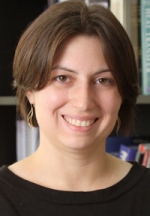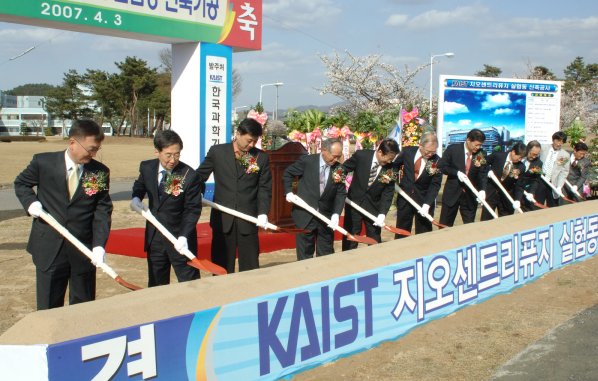Environment
-
 Professor Thompson
Professor Mary Kathryn Thompson of Civil and Environmental Engineering Department wrote her regular column on correlation between art and engineering, “Engineers, Artists Not on Opposite Ends.” The column was published by the Korea Herald on July 23, 2010. For reading, please click the link below.
http://www.koreaherald.com/opinion/Detail.jsp?newsMLId=20100722000548
2010.07.23 View 11638
Professor Thompson
Professor Mary Kathryn Thompson of Civil and Environmental Engineering Department wrote her regular column on correlation between art and engineering, “Engineers, Artists Not on Opposite Ends.” The column was published by the Korea Herald on July 23, 2010. For reading, please click the link below.
http://www.koreaherald.com/opinion/Detail.jsp?newsMLId=20100722000548
2010.07.23 View 11638 -
 Largest Number of Teams Selected From KAIST at 2007 LG Global Challenger Contest
Largest Number of Teams Selected From KAIST at 2007 LG Global Challenger Contest
The largest number of teams has been selected from KAIST at 2007 LG Global Challenger Contest
Despite of the record high competitive rate of 30/ 800, the largest number of teams has been selected from KAIST at 2007 LG Global Challenger Contest.
LG Global Challenger Contest is an exploration program where undergraduate and graduate students perform explorations on their own schedules and share the results with the public online.
Thus far, about 1,500 students from 410 teams have participated in the contest, and the contest is now regarded as the most representative overseas exploration program among university students, showing the average competitive rate of 1/ 20.
Exploration teams are selected by thorough examination and the members of selected teams have to complete the preliminary education program. The exploration teams will perform two-week overseas exploration on their own schedule during the summer vacation and their exploration activities will be relayed through the official web site of the contest by the designated team for online relay.
The exploration teams are obliged to submit the result reports, and the winners of the prize for good reports will be granted scholarship and employment privileges. The followings are the selected teams from KAIST:
Name: U-rekaTopic: U-Eco City, Advanced city where nature and human are well harmonizedMembers: A-Chim Chang (Department of Civil and Environmental Engineering)Hyuk-Il Cho (Department of Computer Sciences)Jung-Hyun Hong (Department of Industrial Engineering)Seung-Kyun Ryu (Department of Computer Sciences)
Name: TWIMTopic: The trend of unmanned ground vehicle development and its influence on unmanned societyMembers: Moon-Jung Byun (Department of Mechanical Engineering)Joon-Seok Park (Department of Electrical Engineering)Hye-Sun Hyun (Department of Electrical Engineering)Jong-Hoon Kim (Department of Electrical Engineering)
Team Impediment-free ODATopic: Future way of Korean ODAMembers: Joon-Youn Kim (Department of Industrial Engineering) Jae-Min Kim (Department of Industrial Engineering)Yoon-Jung Choi (Department of Industrial Engineering)Seul-Ki Lee (Department of Industrial Engineering)
2007.06.12 View 19750
Largest Number of Teams Selected From KAIST at 2007 LG Global Challenger Contest
Largest Number of Teams Selected From KAIST at 2007 LG Global Challenger Contest
The largest number of teams has been selected from KAIST at 2007 LG Global Challenger Contest
Despite of the record high competitive rate of 30/ 800, the largest number of teams has been selected from KAIST at 2007 LG Global Challenger Contest.
LG Global Challenger Contest is an exploration program where undergraduate and graduate students perform explorations on their own schedules and share the results with the public online.
Thus far, about 1,500 students from 410 teams have participated in the contest, and the contest is now regarded as the most representative overseas exploration program among university students, showing the average competitive rate of 1/ 20.
Exploration teams are selected by thorough examination and the members of selected teams have to complete the preliminary education program. The exploration teams will perform two-week overseas exploration on their own schedule during the summer vacation and their exploration activities will be relayed through the official web site of the contest by the designated team for online relay.
The exploration teams are obliged to submit the result reports, and the winners of the prize for good reports will be granted scholarship and employment privileges. The followings are the selected teams from KAIST:
Name: U-rekaTopic: U-Eco City, Advanced city where nature and human are well harmonizedMembers: A-Chim Chang (Department of Civil and Environmental Engineering)Hyuk-Il Cho (Department of Computer Sciences)Jung-Hyun Hong (Department of Industrial Engineering)Seung-Kyun Ryu (Department of Computer Sciences)
Name: TWIMTopic: The trend of unmanned ground vehicle development and its influence on unmanned societyMembers: Moon-Jung Byun (Department of Mechanical Engineering)Joon-Seok Park (Department of Electrical Engineering)Hye-Sun Hyun (Department of Electrical Engineering)Jong-Hoon Kim (Department of Electrical Engineering)
Team Impediment-free ODATopic: Future way of Korean ODAMembers: Joon-Youn Kim (Department of Industrial Engineering) Jae-Min Kim (Department of Industrial Engineering)Yoon-Jung Choi (Department of Industrial Engineering)Seul-Ki Lee (Department of Industrial Engineering)
2007.06.12 View 19750 -
 KAIST to build large-scale civil engineering experiment center
- Geo-Centrifuge experiment center of an area of about 1,712 square meters and an estimated construction cost of total 8.4 billion won
- Simulation laboratory in the field of geotechnical engineering with state-of-the-art experiment equipment- Ground-breaking ceremony held on April 3 at 4 pm
KAIST will construct ‘distributed shared-type Geo-Centrifuge experiment center’, a large-scale civil engineering laboratory that will study natural disasters such as earthquake, embankment collapse, etc. with ground structure miniatures.
A two-story building with a basement occupying an area of about 1,712 square meters will become a landmark laboratory in the field of geotechnical engineering that can be used for the education, research, and social infrastructure design by universities, institutes, and corporations via high-speed information and communication network. The estimated construction cost is 8.4 billion won.
The center will be composed of experiment building including geo-centrifuge laboratory, model-making room, workshop, geotechnical engineering laboratory, and specimen storehouse; and research building including control room, video conference room, electronic library, and research rooms. A variety of convenience facilities for researchers and video conference and remote monitoring system, with which researcher at remote distances can directly participate in experiments, will be provided in the research building, and world’s top-class experiment equipment such as geo-centrifuge with a turning radius of 5 meters, a maximum acceleration of 130 G (130 times faster than the acceleration of gravity), a preload of 2,400 kg and bidirectional shaking-table that can reproduce earthquakes-like wave during experiments, and robots that can reproduce construction procedures by a remote control will be installed.
Geo-Centrifuge experiment refers to an experiment that reproduces natural disaster-like motions by making miniatures of large-scale ground structures such as dams, slopes, etc. and using centrifugal forces generated from high-speed rotation. This experiment can easily and rapidly reproduce actual motions of ground structures at a low cost, thereby being widely used for various geotechnical engineering researches such as evaluation of seismic safety, movement of soft ground, slope stability analysis, etc. The causes of the embankment collapse in New Orleans by Hurricane Katrina in 2005 were also revealed by simulation tests by this experiment.
“The center will make possible a variety of experiments and researches that have never been available in Korea due to the lack of experiment infrastructure, therefore activate researches over the design and construction of large-scale social infrastructures. Making possible civil engineering researches demanding the use of large-scale equipment like Centrifuge, severely dependent on overseas technologies so far, will enhance the global competitiveness of Korean construction industry,” said Dong-soo Kim, President of the center.
The center will be constructed as part of the Ministry of Construction & Transportation (MOCT)’s project for the establishment of distributed shared-style construction research infrastructure, which is designed to establish construction research infrastructures in a national level. The ground breaking ceremony was held at KAIST on April 3 at 4 pm.
2007.04.12 View 17689
KAIST to build large-scale civil engineering experiment center
- Geo-Centrifuge experiment center of an area of about 1,712 square meters and an estimated construction cost of total 8.4 billion won
- Simulation laboratory in the field of geotechnical engineering with state-of-the-art experiment equipment- Ground-breaking ceremony held on April 3 at 4 pm
KAIST will construct ‘distributed shared-type Geo-Centrifuge experiment center’, a large-scale civil engineering laboratory that will study natural disasters such as earthquake, embankment collapse, etc. with ground structure miniatures.
A two-story building with a basement occupying an area of about 1,712 square meters will become a landmark laboratory in the field of geotechnical engineering that can be used for the education, research, and social infrastructure design by universities, institutes, and corporations via high-speed information and communication network. The estimated construction cost is 8.4 billion won.
The center will be composed of experiment building including geo-centrifuge laboratory, model-making room, workshop, geotechnical engineering laboratory, and specimen storehouse; and research building including control room, video conference room, electronic library, and research rooms. A variety of convenience facilities for researchers and video conference and remote monitoring system, with which researcher at remote distances can directly participate in experiments, will be provided in the research building, and world’s top-class experiment equipment such as geo-centrifuge with a turning radius of 5 meters, a maximum acceleration of 130 G (130 times faster than the acceleration of gravity), a preload of 2,400 kg and bidirectional shaking-table that can reproduce earthquakes-like wave during experiments, and robots that can reproduce construction procedures by a remote control will be installed.
Geo-Centrifuge experiment refers to an experiment that reproduces natural disaster-like motions by making miniatures of large-scale ground structures such as dams, slopes, etc. and using centrifugal forces generated from high-speed rotation. This experiment can easily and rapidly reproduce actual motions of ground structures at a low cost, thereby being widely used for various geotechnical engineering researches such as evaluation of seismic safety, movement of soft ground, slope stability analysis, etc. The causes of the embankment collapse in New Orleans by Hurricane Katrina in 2005 were also revealed by simulation tests by this experiment.
“The center will make possible a variety of experiments and researches that have never been available in Korea due to the lack of experiment infrastructure, therefore activate researches over the design and construction of large-scale social infrastructures. Making possible civil engineering researches demanding the use of large-scale equipment like Centrifuge, severely dependent on overseas technologies so far, will enhance the global competitiveness of Korean construction industry,” said Dong-soo Kim, President of the center.
The center will be constructed as part of the Ministry of Construction & Transportation (MOCT)’s project for the establishment of distributed shared-style construction research infrastructure, which is designed to establish construction research infrastructures in a national level. The ground breaking ceremony was held at KAIST on April 3 at 4 pm.
2007.04.12 View 17689